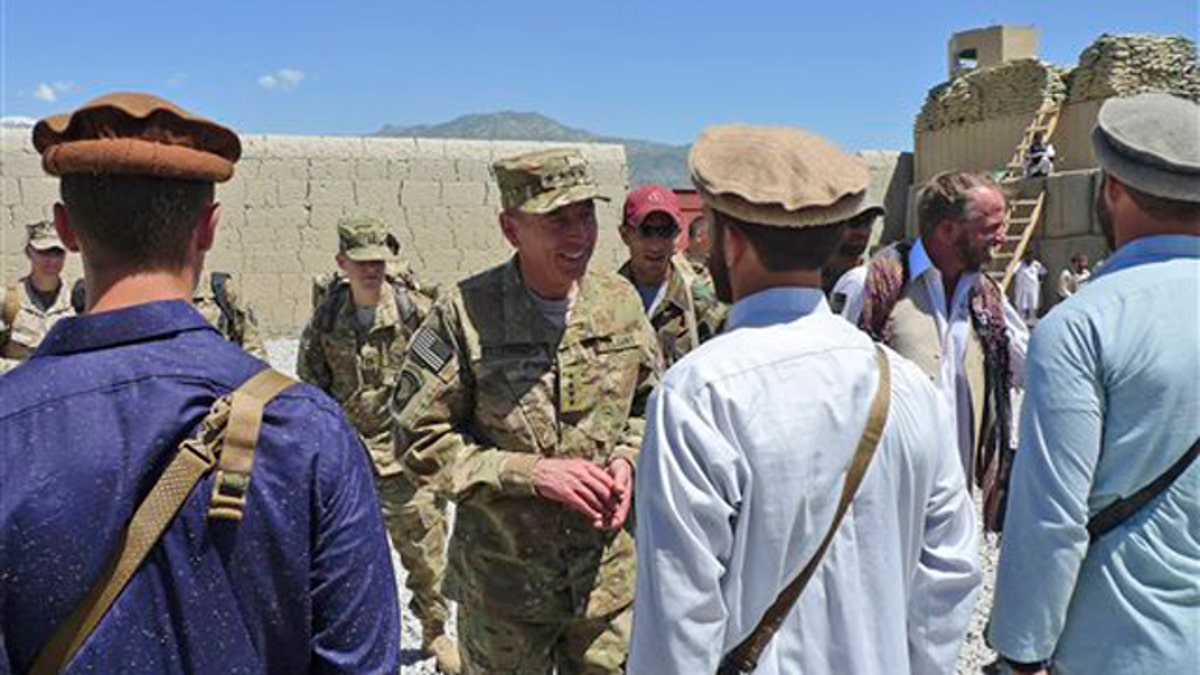
Gen. David Petraeus, center, commander of the NATO International Security Assistance Force (ISAF) meets with special forces in Kunar province in eastern Afghanistan May 8. (AP)
Gen. David Petraeus, the top U.S. commander in Afghanistan who will soon become CIA director, credits increased use of Afghan special operations forces trained by U.S. troops with helping blunt Taliban momentum, largely by taking out militant leaders.
Less well-known is the model Petraeus has supported alongside the expanded raids, whereby special operations troops pair with Afghans to provide protection, while training forces from local police to Afghanistan's own special operators to take their place. The fledgling success of such units marks a subtle shift toward Afghan independence, and a possible exit strategy for the U.S.
While U.S. officials say Petraeus is being super tight-lipped about any possible withdrawal of U.S. forces from Afghanistan, some claiming to be in the know are looking at possibly 10,000 fewer Americans in Afghanistan by year's end and a concentration on special forces to train Afghan commandos.
As the U.S. prepares to draw down its troop presence to meet President Obama's pledge to begin withdrawing American forces in July, the scope and numbers are a well-guarded secret.
"He's not sharing anything with anyone," a senior U.S. officer speaking of Petraeus told Fox News on Tuesday, "on the timing of what he'll submit, on what the options/recommendation will be or on anything else. And anyone who claims to have insights on this is speculating without any basis for that."
The officer said the only people who are in on the proposal to be presented to the president are Gen. James N. Mattis, head of Central Command; Adm. Mike Mullen, chairman of the Joint Chiefs of Staff; and Defense Secretary Robert Gates.
"No one outside that group is privy to the process or thinking."
But that hasn't stopped the talk of a plan. According to The Wall Street Journal, U.S. military officers in Afghanistan are working up preliminary proposals to withdraw as many as 5,000 troops from the country in July and as many as 5,000 more by year's end. That's about 10 percent of the 100,000-strong U.S. military presence there -- though another defense official told Fox News the outline is not coming from Petraeus' office and "nothing has been forwarded from Petraeus up the chain."
Three senior administration officials and two officials in Congress told The Associated Press under condition of anonymity that a proposed scenario for a future model of U.S. force structure in Afghanistan would include U.S. Army Green Berets, Marine Special Operations troops and Navy SEALs to mentor and fight alongside Afghans for possibly a decade to come.
There would still be 20,000 to 30,000 U.S. forces on the ground by the end of 2014, when the Afghans are supposed to be "in the lead" in the fight, one of the senior officials said. But with relatively fewer U.S. troops than the Afghans, the U.S. would be backing them up rather than fighting the battles for them.
Some 10,000 U.S. special operations forces are now in Afghanistan -- roughly 4,000 "direct action" forces that target militants, and some 6,000 troops like Green Berets that mentor Afghan commandos and local policing forces, according to multiple U.S. officials.
These numbers would probably hold steady as conventional forces draw down. According to the Wall Street Journal, some of the troops to leave in July will be combat forces but commanders also hope to cut support staff to minimize the impact of that reduction while still fulfilling Obama's December 2009 pledge to begin withdrawals. The president made that promise when he announced the surge of an additional 30,000 forces.
The plan's backers told the AP that some worry the White House may draw down conventional troops before the U.S.-backed Afghan special operating forces have a chance to mature, leaving the U.S. special-ops-backed Afghans vulnerable to being overrun and reliant on a skeleton crew of U.S. logistics, communications and intelligence resources.
Petraeus would not say whether a special operations-led model was one of the options he planned to present to the White House in advance of Obama's July deadline but he did praise the Afghans during an interview with the AP.
"Targeted intelligence-driven operations are increasingly led by Afghan special operations forces," with little American help, Petraeus said. Such Afghan-led forces conduct three to four raids a week against militant targets in the capital, he said.
The top tier of the Afghan forces -- known as the Afghan Commandos -- run operations that mirror the bin Laden raid in many ways: helicoptering into missions to search a village for a suspect, storming a target in large numbers to quickly overwhelm the enemy.
A U.S. special operations officer who has worked with the Kabul-based commandos for six months said they were already planning and executing most of their own missions when he arrived, only calling on the Americans if they needed helicopters, extra firepower or occasional advice. The commandos would headline a new Afghan special operations command, to be established in the next few months.
Commando battalions are still uneven, depending on leadership. Some don't show up on time, and some still use hashish and opium on duty, multiple special operations officers concede. Many Afghan force overall are illiterate.
But the commandos perform well under fire, one U.S. officer who fought alongside them said. And their progress has freed up some U.S. forces to begin a separate training mission for a unit patterned after U.S. Green Berets.
Only 150 strong so far, the Afghan "Tan Berets" work in teams of 18 to 20 men, according to their Afghan commander, Lt. Col. Mohmand Zabihullah.
Zabihullah said special forces soldiers must have high school literacy levels, much higher than the commandos' required third-grade level. They must also survive a tougher physical fitness selection process, and a three-month training program that weeds out roughly a third of the applicants, he said.
Anyone caught using drugs is expelled, he said.
The final piece is the Afghan local police, designed as a paid, armed village security force, intended both to empower locals to protect their own territory and to give them an economic alternative to working for the Taliban.
Previous such forces have gone rogue because of lack of oversight. U.S. and Afghan officials insist they've now got the formula right, by giving local Afghan officials some control over membership, and by vetting every potential inductee with background checks and biometric testing to keep out known militants or criminals. The U.S. special forces units in the village also provide oversight.
More than 5,000 Afghans have gone through the three weeks of training, to serve in the 40-plus districts that have agreed to the program.
Fox News' Jennifer Griffin and The Associated Press contributed to this report.




